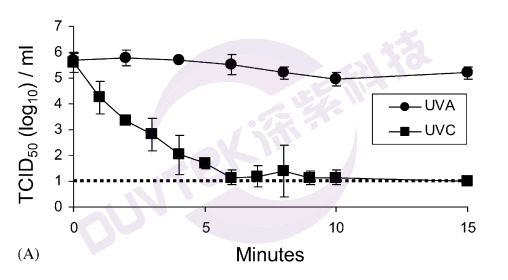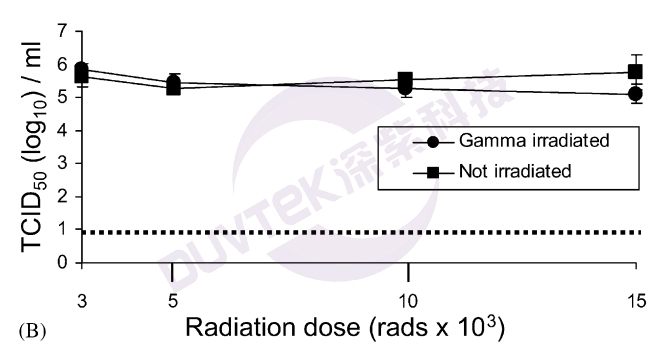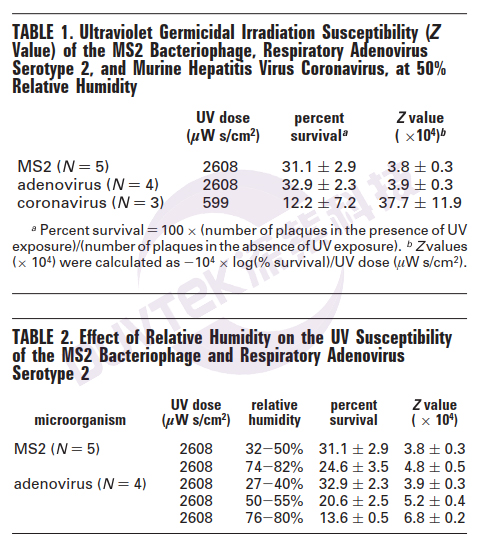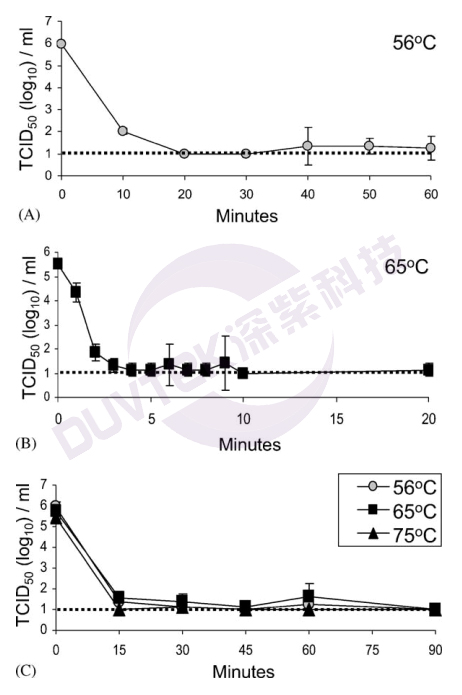Survey of novel coronavirus dose in NCP by UVC-LED deep ultraviolet radiation
Author: Chen Jingwena, Liang Renzhea, Wang Haob
A Hubei Shenzi Technology Co., Ltd., building B08, Donghu hi tech creative city, Liangzihu District, Ezhou City, Hubei Province
B Wuhan National Research Center of optoelectronics, Huazhong University of science and technology, 1037 Luoyu Road, Hongshan District, Wuhan City, Hubei Province
Hubei DUVTek Co., Ltd. original content, reprint please indicate the source.
Abstract:According to the ultraviolet killing dose of betacoronavirus, such as SARS and mers, tcid is given50The initial concentration is about 105.8Novel coronavirus NCP of , /mL 2019-nCoV has a 99.99% UV lethal dose of 1445 mJ/cm.2The basic model of deep UV LED for surface anti-virus and air purification is given, which can be used for various application development.
1. Background
The novel coronavirus outbreaks in Wuhan have been exposed for more than two months. A large number of medical resources are invested in patients, treatment methods, drug efficacy screening, epidemic prevention and control. Novel coronavirus pneumonia treatment plan released by the national health and Health Committee (trial version fourth)[1]"The understanding of the physical and chemical characteristics of coronavirus comes from the study of SARS CoV and mers cov. The virus is sensitive to ultraviolet rays and heat, at 56 ℃ for 30 minutes, ether It can effectively inactivate the virus... ". The physical and chemical characteristics of coronavirus make it feasible to use ultraviolet disinfection technology to kill coronavirus on various surfaces, air and water. A large number of ultraviolet equipment and high virus concentration environment such as hospitals are put into use[2, 3]。 The UV LED industry news also mentioned that the team of Dong Xiaoping, an expert from the Institute of viral disease control and prevention of the Chinese Center for Disease Control and prevention, found that the coronavirus could be killed in 30 minutes by UVC irradiation with an intensity greater than 90 μ w / cm? 2[4]。 No novel coronavirus NCP 2019-nCov has been shown to be expressed in the ultraviolet lethal dose or experimental data so far. In the actual application of UV technology, the application environment, target killing rate, UV intensity and dose are the technical indicators that must be considered. The lack of quantitative experimental data will make the application of UV lamp or UV LED stay at the qualitative or empirical level.
Of course, novel coronavirus NCP 2019-nCoV has great difficulty in UV dose and kinetics research because of limited experimental resources. Therefore, during the SARS epidemic period, the research on mouse hepatitis coronavirus (MHV) provides a very good scientific basis for the discovery, identification and understanding of its physical and chemical characteristics. according to the understanding of[5]There are four genera of coronavirus, namely alphacorona virus, betacoronavirus, deltacorona virus and gamma corona virus. The highly pathogenic coronaviruses SARS CoV and mers CoV, as well as the model virus MHV used to study the molecular virology of coronavirus, belong to betacoronavirus. The genome of this virus is a single stranded positive RNA with a length of about 300000 nucleic acids, which is one of the largest RNA viruses in the genome. MHV, SARS CoV, mers CoV and NCP 2019 ncov have high homology and structural homology, so their resistance to ultraviolet rays has similarity and mutual reference.
Based on the above facts, this paper reviews the UV killing data of several coronaviruses, such as SARS CoV and MHV cov in some literatures, and presents the UVC UV dose and influence conditions required for virus killing in surface and air, so as to guide the development of uvc-led applications. The specific process of virus culture and experiment is not the focus of this paper. We can refer to the references and will not repeat here. At the same time, in view of the fact that in the year when the references were published, deep UV uvc-led was not a popular technology, so the light sources used were all ultraviolet mercury lamps, which does not mean that it has no reference significance for the scheme design of deep ultraviolet uvc-led. Furthermore, the killing efficiency of 275 nm deep UV LED is the same as that of 254 nm UV lamp. Here we can also compare the killing data of lamp tubes to that of deep UV LED.
2. UV dose required to kill coronavirus on surface of object

Fig. 1 Relationship between survival of SARS CoV coronavirus and exposure time under UVC and UVA UV irradiation[6]
In 2004 [6] and 2006 [7], the Taylor team of the center for biological evaluation and research of the U.S. Food and drug administration showed that under the irradiation of deep ultraviolet light source with characteristic wavelength of 254 nm and radiation intensity of 4016 μ w / cm 2, tcid had a significant effect on tcid50The initial concentration is about 105.8 /ML of SARS-Cov virus sample was partially killed after 1 minute, with a survival rate of~10/mL and a killing rate of over 99.99% after 6 minutes; ≤ 1.0 TCID after 10 minutes50 (log10)The killing rate can be considered as & gt; 99.9999%. It can also be seen from the table that there is a positive correlation between the log value of the killing rate and the cumulative radiation dose (here is the irradiation time), and there is a linear relationship before the log is lower than 4. So at 105.8 /At a virus concentration of mL, the required UV dose for 99.99% killing rate is 1445 mJ/cm2。 According to the linear relationship between the log value of the just killing rate and the dose, it is not difficult to obtain that the dose required for 99.9% killing rate is 722 MJ / cm2。 However, UVA (365 nm, 2133 μ w / cm? 2) did not kill SARS CoV coronavirus.
Dong Xiaoping's team [8] reported in 2003 that the coronavirus can be killed in 60 minutes after UVC irradiation with a intensity of & gt; 90 μ w / cm? 2 (note that the original text is 60 minutes instead of the 30 minutes previously mentioned in the news), and the cumulative dose converted is 324 MJ / cm2, lower than the 1445 MJ / cm of Taylor team2This may be due to differences in experimental conditions or virus sample sources, and the data of Dong Xiaoping's team did not give specific log values, so there is a 5-fold difference (the log value reflected in the killing rate is only 0.5). From the point of view of performance redundancy, it is suggested that the application manufacturer should require 1445 MJ / cm according to 99.99% killing rate2Dose.
The above SARS CoV virus used for killing experiments was dispersed in phosphate solution, which could be similar to the situation on the surface of objects and in water. Of course, coronaviruses in tissue fluids, such as blood, have been shown not to be killed directly by ultraviolet radiation[7]。

Fig. 2 killing ability of different doses of gamma rays on SARS CoV[6]
It is worth mentioning that gamma rays (up to 15000 RAD), which can destroy human normal cells and cancer cells, have little killing effect on SARS virus.
3. Ultraviolet dose required to kill coronavirus in air

Fig. 3 survival rate of coronavirus aerosol under ultraviolet radiation and its relationship with humidity[9]
In a single circulation duct with a flow rate of 12.5 L / min and a diameter of 50 × 260 × 455 mm (height × width × length), the concentration of aerosol virus was 104~105 Air with PFU/mL and humidity of 50% Rh. Use a 36W ultraviolet mercury lamp tube (to isolate ozone) to illuminate inward from the 455mm surface of the pipeline, and adjust the ultraviolet radiation intensity close to the window to 599 μ W/cm ², After stable operation for 15 minutes, the killing rate of MHV coronavirus in the single cycle air outlet sampling group was 87.8% compared to the control group. The data in Table 2 also indicates that the killing rate of virus aerosols is higher under high humidity.
The above data provide data support for air anti-virus scenario. Basically, it can be converted into circulating air mode. In order to achieve the killing rate of MHV coronavirus in the air of 30 cubic meters in 2 hours and 30 cubic meters, 320pcs of 10MW 275nm uvc-led lamp beads are needed, which is far more than the number of lamp beads in natural bacteria scene (theoretical calculation results are 2 ~ 4pcs)[10], related to product structure). The 99.99% surface killing dose of Escherichia coli was about 13.2 MJ / cm2In the second section of this paper, the dose of SARS virus is 110 times that of SARS virus, which is basically consistent with that of air purification. Then, in order to apply in the actual scene, it is necessary to change the working time of uvc-led to 24h continuous on, so that the number of uvc-led needed to be configured in 30 cubic meters is 27 PCs, which can meet the cost demand of commercial application. It is speculated that this dose relationship can also be referred to in static water and flowing water.
4. Novel coronavirus UVC NCP 2019-nCoV killing dose of ultraviolet radiation

Fig. 4 Relationship between survival of SARS CoV and heating time at different temperatures[6]
The experimental data show that the killing rate of SARS CoV can be more than 99.999% when heated at 56 ℃ for 20 min, and the time required at 65 ℃ can even be reduced to 10 min. Although there is information that NCP 2019 ncov can be killed by heating at 56 ℃ for 30 min. However, there is no analogy between thermal resistance and UV resistance, so the UV resistance of NCP 2019 ncov can not be scientifically deduced from the physical and chemical characteristics of SARS, which can only be used as a reference. Kurt Bedell, BS, University of Iowa, USA, gave 8.9 × 10 of the same genus betacoronavirus coronavirus at a distance of 1.22 meters5 The required time for killing MHV-A59 and MERS CoV at a concentration of pfu/mL is 10 minutes and 5 minutes, respectively, with a two-fold difference in lethal dose[11]。 However, as mentioned above, the log value reflected in the killing rate is only 0.3. When the log base is high, the difference between 99.9% and 99.95% can be ignored in production.
5. Conclusion
As the virus is rampant, enterprises in the deep ultraviolet LED industry are duty bound to go further in the development of effective solutions and the supply of core devices. We hope that the 1445 MJ / cm described in this paper can be used as a reference2 99.99% lethal dose (virus TCID)50The initial concentration is about 105.8&And the corresponding surface disinfection and air purification models help to develop various types of deep UV LED applications. Hubei Shenzhen purple technology novel coronavirus is a LED limited company with independent intellectual property rights. It hopes to join hands with like-minded manufacturers to fight the new coronavirus epidemic.
6. References
[1] New novel coronavirus pneumonia treatment plan (trial version fourth) [Z].2020.
[2] Under the epidemic situation, we should know about these knowledge points of ultraviolet sterilization! [EB/OL]. https://www.ledinside.cn/news/20200204-46872.html .
[3] The novel coronavirus pneumonia epidemic in Hubei is being rushed to Hubei. Shenzhen purple technology released UVC UV assessment tool [EB/OL].https://www.duvtek.com/article/121/.
[4] Experts say -Emma. novel coronavirus [EB/OL]. is UVC's battle for human body protection. http://www.hangjianet.com/v5/topicDetail?id=1579666952308 .
[5] China.com news. What lessons can novel coronavirus learn from SARS? [EB/OL]. https://news.china.com/socialgd/10000169/20200121/37728369_ all.html#page_ 2.
[6] Darnell M E R, Subbarao K, Feinstone S M, et al. Inactivation of the coronavirus that induces severe acute respiratory syndrome, SARS-CoV[J]. Journal of Virological Methods, 2004,121:85-91.
[7] Darnell M E, Taylor D R. Evaluation of inactivation methods for severe acute respiratory syndrome coronavirus in noncellular blood products[J]. Transfusion, 2006,46(10):1770-1777.
[8] Duan S M, Zhao X S, Wen R F, et al. Stability of SARS coronavirus in human specimens and environment and its sensitivity to heating and UV irradiation[J]. Biomed Environ Sci, 2003,16(3):246-255.
[9] Walker C M, Ko G. Effect of Ultraviolet Germicidal Irradiation on Viral Aerosols[J]. Environment Science & Technology, 2007,41(15).
[10] Hubei Shenzi Technology Co., Ltd. deep UV uvc-led air sterilization effect evaluation tool [EB / OL]https://www.duvtek.com/solution/6/.
[11] Kurt Bedell B, Buchaklian A H, Stanley Perlman M. Efficacy of an Automated Multiple Emitter Whole-Room Ultraviolet-C Disinfection System Against Coronaviruses MHV and MERS-CoV[J]. infection control & hospital epidemiology, 2016,37(5):598-599.
Development of deep UV LED
Technology sharing · December 6, 2020 · 1318 views
Professor Chen Changqing, chairman of the board of deep violet technology, was invited to give the conference report "semiconductor UV LED and its application
Company News, December 29, 2017, 870 views
The source of wisdom and life -- the application of deep UV in water purifier
Technology sharing · May 27, 2021 · 201 views
Good News | Warmly Celebrating Our Company's Dr. Chen Jingwen's Selection into the "China Optics Valley 3551 Talent Plan"
Company News, June 28th, 141 views
Water related approval approved, and Youweixin has obtained authoritative certification in the field of drinking water hygiene and safety
Company News, September 24th, viewed 97 times
Youweixin has won the first prize in the Wuhan Science and Technology Innovation Competition!
Company News, January 15th, 33 views
[video tutorial] deep design of deep UV uvc-led sterilization scheme
Technology sharing · February 11, 2020 · 1410 views
Is 230nm UVLED light harmless to human body? The German research team has used it against hospitals
Industry Information · June 14, 2020 · 524 views
